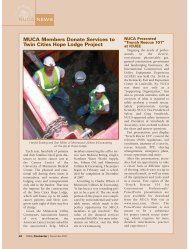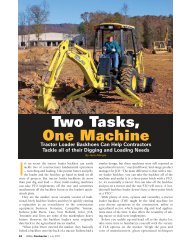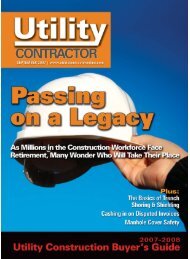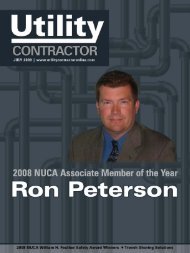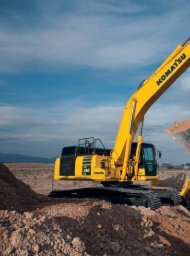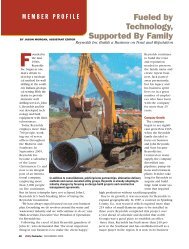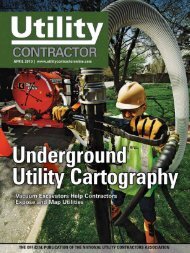View Full December PDF Issue - Utility Contractor Online
View Full December PDF Issue - Utility Contractor Online
View Full December PDF Issue - Utility Contractor Online
You also want an ePaper? Increase the reach of your titles
YUMPU automatically turns print PDFs into web optimized ePapers that Google loves.
without the strong, steadfast support of NUCA members<br />
and chapters around the country.<br />
Infrastructure Groups Keep<br />
the Pressure On<br />
The beginning of the 112th Congress saw an influx<br />
of new lawmakers, with 16 new Senators (3 Democrats<br />
and 13 Republicans) and 93 new House lawmakers (84<br />
Republicans and 9 Democrats). In the 2010 Election, 55<br />
incumbents were voted out (53 Democrats and 2 Republicans),<br />
and strong demands to rein in government<br />
spending from newly elected Republican lawmakers<br />
seemed to dominate the national debate. Therefore, efforts<br />
to increase the federal ante for American infrastructure<br />
proved to be an increasingly hard sell.<br />
The need to invest in America’s underground environmental<br />
infrastructure is well known and documented.<br />
According to the Environmental Protection Agency<br />
(EPA), hundreds of billions of dollars are needed to repair<br />
and rebuild America’s underground environmental<br />
infrastructure, yet the lack of public dollars has kept the<br />
construction industry on the sidelines. In fact, the construction<br />
industry has been the hardest hit sector of the<br />
economic downturn and continues to face an unemployment<br />
rate well over 10 percent. Construction firms that<br />
work on public water and wastewater infrastructure projects<br />
likely face significantly higher unemployment than<br />
other sectors of the industry.<br />
Investment in water and wastewater infrastructure creates<br />
a myriad of high-paying jobs, generates significant<br />
economic activity and expands the local tax base. In fact,<br />
a recent study conducted by the Clean Water Council<br />
found that every $1 billion invested in water and wastewater<br />
infrastructure can: create up to 27,000 new jobs<br />
with average annual earnings of more than $50,000;<br />
generate a national output (i.e. demand for products and<br />
services in all industries) of up to $3.46 billion; and bring<br />
more than $1 billion in personal (spending) income.<br />
Importantly, a $1 billion investment would generate approximately<br />
$82.4 million in state and local tax revenue.<br />
EPA State Revolving Fund Programs<br />
Face Harsh Cuts in Appropriations<br />
As is increasingly the case, Congress has found it impossible<br />
in recent years to pass appropriations measures<br />
for all federal agencies. Consequently, a “continuing<br />
resolution” won out in the FY 2011 spending package<br />
for the EPA State Revolving Fund (SRF) programs. After<br />
suffering a nearly $1 billion reduction in SRF funding<br />
under the FY 2011 continuing resolution, funding<br />
for the Clean Water SRF was reduced to $1.55 billion<br />
from $2.1 billion in the original FY 2011 package, and<br />
the Drinking Water SRF was cut to $990 million, down<br />
from $1.4 billion. In total, the SRF programs received<br />
an appalling $2.5 billion, down from approximately<br />
$3.5 billion in the original FY 2011 package, reflecting<br />
a 27 percent reduction in total SRF funding.<br />
To make matters worse, FY 2012 SRF funding<br />
faces further cuts in the face of the energized fiscal<br />
hawks in the House Republican majority. In fact,<br />
House Republicans are looking to return to the FY<br />
2008 levels of the Bush Administration, providing<br />
$689 million to the Clean Water SRF and $829 million<br />
for the Drinking Water SRF in FY 2012. Obviously,<br />
NUCA recognizes the need to think outside<br />
the box on water infrastructure investment.<br />
New T&I Water Legislation Takes<br />
Comprehensive Approach<br />
Later in the year, new legislation (HR 3145) was<br />
introduced by Democrats on the House Transporta-<br />
NUCA knows Capitol Hill: CEO Bill Hillman (right)<br />
and Vice President of Government Relations Eben<br />
Wyman (center) ensure Representatives like Eric<br />
Cantor (R-VA-7th District) understand the utility<br />
construction agenda.<br />
<strong>December</strong> 2011 | <strong>Utility</strong> <strong>Contractor</strong> 13




